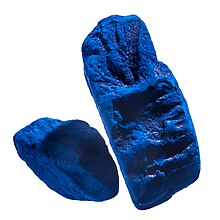
Back صبغة النيلة Arabic رنق نیل AZB Індыга Byelorussian Индиго Bulgarian Indigo BS Indi (colorant) Catalan Indigo Czech Indigo (farvestof) Danish Indigo German Indigo (farbo) Esperanto
 | |
 | |
 | |
| Names | |
|---|---|
| Preferred IUPAC name
[2(2')E]-[2,2'-Biindolylidene]-3,3'(1H,1'H)-dione | |
| Other names
2,2'-Bis(2,3-dihydro-3-oxoindolyliden), Indigotin
| |
| Identifiers | |
3D model (JSmol)
|
|
| ChEMBL | |
| ChemSpider | |
| ECHA InfoCard | 100.006.898 |
PubChem CID
|
|
| RTECS number |
|
| UNII | |
CompTox Dashboard (EPA)
|
|
| |
| |
| Properties | |
| C16H10N2O2 | |
| Molar mass | 262.27 g/mol |
| Appearance | dark blue crystalline powder |
| Density | 1.199 g/cm3 |
| Melting point | 390 to 392 °C (734 to 738 °F; 663 to 665 K) |
| Boiling point | decomposes |
| 990 µg/L (at 25 °C) | |
| Related compounds | |
Related compounds
|
Indoxyl Tyrian purple Indican |
Except where otherwise noted, data are given for materials in their standard state (at 25 °C [77 °F], 100 kPa).
| |
Indigo dye is an organic compound with a distinctive blue color. Indigo is a natural dye obtained from the leaves of some plants of the Indigofera genus, in particular Indigofera tinctoria. Dye-bearing Indigofera plants were once common throughout the world. It is now produced via chemical routes. Blue colorants are rare. Since indigo is insoluble, it is also referred to as a pigment (C.I. Pigment Blue 66, C.I.).[1]
Most indigo dye produced today is synthetic, constituting around 80,000 tonnes each year, as of 2023.[2] It is most commonly associated with the production of denim cloth and blue jeans, where its properties allow for effects such as stone washing and acid washing to be applied quickly.
- ^ Cite error: The named reference
Ullmannwas invoked but never defined (see the help page). - ^ Linke, Julia A.; Rayat, Andrea; Ward, John M. (2023). "Production of indigo by recombinant bacteria". Bioresources and Bioprocessing. 10 (1): 20. doi:10.1186/s40643-023-00626-7. ISSN 2197-4365. PMC 10011309. PMID 36936720.